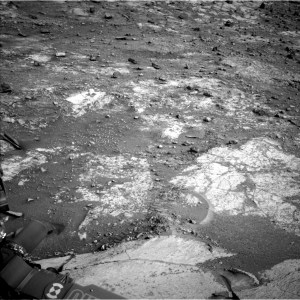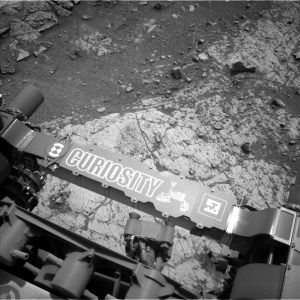2 min read
Sol 4294: Return to McDonald Pass
Earth planning date: Tuesday, Sept. 3, 2024
Curiosity has returned to “McDonald Pass,” a block within Gediz Vallis that we first spotted about a month ago (as seen in the above Front Hazcam image). The block shows some interesting zonation — the distribution of textures and colors into different areas, or zones. We’re hoping that by studying the well-exposed relationships between white, gray, and tan material at this location that we’ll be able to better understand similar relationships that we’ve observed elsewhere. The drive over the weekend got us back to McDonald Pass, but perhaps one step too far. We realized that the best spot to study these zones is directly beneath the rover, so today’s plan includes contact science and a short bump to position the rover for even more science tomorrow.
Today was a rare one-sol plan, to account for the U.S. holiday yesterday. I was on shift as the Long Term Planner and it was a fairly straightforward day once we established the best locations for contact science. The plan starts with a DRT and APXS on the central part of the slab, at a target named “Erin Lake.” Then we have a remote sensing block, which begins with some environmental monitoring to search for dust devils, measure atmospheric opacity, and monitor the movement of fines on the rover deck. The Geology Theme group planned ChemCam LIBS on the darker gray rim of this block at “Paris Lake,” along with a ChemCam passive observation on an interesting dark float block nearby. There’s also a long distance RMI mosaic to assess the yardang unit higher on Mount Sharp, and a Mastcam mosaic to evaluate the textures in a row of large clasts. Later in the afternoon, Curiosity will acquire MAHLI images of Erin Lake and another target, “Picture Puzzle,” which captures the white, gray, and tan zones. Then Curiosity will take a short drive back about 1 meter (about 3.3 feet) to position a white and gray clast in our workspace for even more contact science tomorrow.
Will McDonald Pass be the key to understanding the zonation observed in blocks throughout this region? Stay tuned!
Written by Lauren Edgar, Planetary Geologist at USGS Astrogeology Science Center
Share
Details
Related Terms
Discover More Topics From NASA






